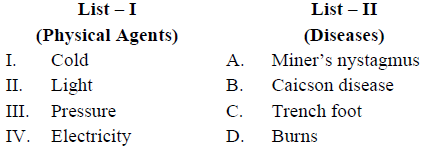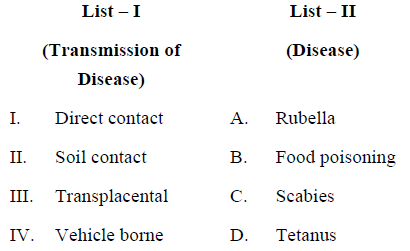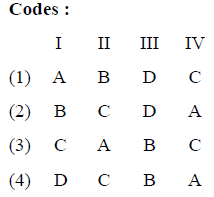SOCIAL MEDICINE & COMMUNITY HEALTH
Paper – II
Note : This paper contains fifty (50) objective type questions of two (2) marks each. All questions are compulsory.
1. Which report exemplifies the “Cultural Behavioural” explanations for inequalities in health ?
(1) NHS Management Inquiry Report 1983
(2) Chadwick’s Report on Sanitary Conditions 1842
(3) Guffith’s Report 1983
(4) The Black Report 1980
2. Testing of experimental drugs on humans is termed as
(1) In-vitro fertilisation
(2) Prognosis
(3) Clinical trial
(4) Vaccination
3. Japanese encephalitis is transmitted by
(1) Mosquitoes
(2) Flies
(3) Soft Tick
(4) Hard Tick
4. The hospital acquired infectious are more likely to occur in
(1) ICU of tertiary care hospitals
(2) District hospitals
(3) CHCS
(4) PHCS
5. Under the Vitamin A distribution scheme 2,00,000 I.U. are given orally in India between 1 to 6 years age with correct frequency of every
(1) 3 months
(2) 4 months
(3) 6 months
(4) 12 months
6. Following are the responsibilities of ASHA worker in new-born care except
(1) measuring new-born temperature
(2) weighing the new-born
(3) early bath with soap and water
(4) promoting hand washing
7. A child aged less than 2 months had convulsion breathing rate of > 62 / per minute Nasal flaring axillary temp 36 – 8 °C. As per IMNCI plus, what will be the classification ?
(1) Severe Pneumonia
(2) Pneumonia
(3) Possible serious bacterial infection
(4) Local bacterial infection
8. Multidrug resistance in TB is defined as resistance to
(1) Streptomycin, Rifampicin and Isoniazid (INH)
(2) Streptomycin and Rifampicin
(3) Isoniazid and Rifampicin
(4) Streptomycin and Isoniazid
9. Which of the following is true for point source epidemic ?
(1) Secondary waves occur
(2) There is a rapid rise in the wave which flattens and tails off gradually over period of time.
(3) It is propagative
(4) All cases occur in a single incubation period of the disease.
10. Sub-centre B is expected to conduct
(1) 10 deliveries per month
(2) 15 deliveries per month
(3) 20 deliveries per month
(4) 25 deliveries per month
11. Types of screening are
I. Mass screening
II. Low-Risk screening
III. High-Risk screening
IV. Multi-phasic screening
(1) I, II and III are correct
(2) I, III and IV are correct
(3) I, II and IV are correct
(4) I and IV are correct
12. Which of the following characteristics a questionnaire ?
I. Economical
II. Wider distribution
III. Literate respondents
IV. Face to Face interaction
Codes :
(1) II, III and IV
(2) I, III and IV
(3) I, II and III
(4) I, III and IV
13. Emile Durkheim has authored the following books :
I. Economy and Society
II. The Division of Labour in Society
III. The Rule of Sociological method
IV. The Poverty of Philosophy
(1) I, II and III are correct.
(2) I & IV are correct.
(3) II and III are correct.
(4) II, III & IV are correct.
14. The minimum information needed to calculate sample size for randomized clinical trials :
I. Power of study
II. Level of significance
III. Size of treatment effect
IV. Internal validity
(1) I, II and III are correct.
(2) II and IV are correct.
(3) II, III and IV are correct.
(4) I and IV are correct.
15. Important features of cluster sampling are :
I. Everybody in the population has an equal chance of being included in the sample.
II. Data collection takes less time
III. The sample group appears to grow like a rolling snowball.
IV. It is less expensive.
(1) I, II and III are correct.
(2) II and IV are correct.
(3) I, III and IV are correct.
(4) I and IV are correct.
16. Communicable diseases / infections incriminated as possible cause of the following noncommunicable diseases :
I. Bell’s palsy
II. Insulin dependent diabetes
III. Reactive arthritis
IV. Glioma
(1) I, II, III
(2) II, III, IV
(3) I, III, IV
(4) II, I, IV
17. The macro-economics consequences (economy) due to NCDs are
I. Reduced labour force from mortality, absenteeism, disability
II. Higher Dependency ratio
III. High household expenditure which include health care.
IV. Reduced access to factors of production
(1) I, II, III
(2) II, III, IV
(3) III, IV, I
(4) I, II, IV
18. The surveillance cycle consists of
I. Collection of data
II. Consolidation and interpretation
III. Dissemination
IV. Action to control and prevent
(1) I, II, III
(2) II, III, IV
(3) I, III, IV
(4) I, II, III, IV
19. The disadvantages of a cohort study are
I. Need to study large numbers
II. May take many years
III. Circumstances may change during study
IV. Cannot calculate rates
(1) I, II, III
(2) I, II, IV
(3) II, III, IV
(4) III, IV, I
20. Fever alert surveillance in India mainly covers the following diseases :
I. Dengue fever
II. Chikungunya
III. Tuberculosis
IV. Rocky mountain spotted fever
Codes :
(1) I and II
(2) II and III
(3) I and III
(4) III and IV
Assertion and Reasoning in the context of two statements, which one of the following is correct :
(1) Both (A) and (R) are true and (R) is the correct explanation.
(2) Both (A) and (R) are true, but (R) is not the correct explanation.
(3) (A) is true but (R) is false.
(4) (A) is false but (R) is true.
21. Assertion (A) : Exposure to lead occurs only in the battery manufacturing industry.
Reason (R) : Lead poisoning may occur by inhalation, ingestion and by skin contact.
22. Assertion (A) : Reports from several countries have shown that areas supplied with soft drinking water have higher prevalence of arteriosclerotic heart disease
Reason (R) : Food cooked in soft water returns its natural colour and appearance.
23. Assertion (A) : Social facts are the first and foremost ‘things’ which are social in nature.
Reason (R) : Such things are considered to be internal in nature.
24. Assertion (A) : Iodization of salt is the most widely used prophylactic public health measure against IDD.
Reason (R) : The best source of iodine are sea foods.
25. Assertion (A) : Bagassosis has been shown to be due to a thermophilic actinomycete etc.
Reason (R) : Fungicidal agents are the most effective treatment for a case of bagassosis.
26. Assertion (A) : Pregnancy in adolescence constitutes 11% of all pregnancies in most developing countries and also in some developed countries such as U.S.A.
Reason (R) : These are ‘at risk’ pregnancies and lead to serious public health problems.
27. Assertion (A) : Bidi smokers have a higher risk of developing lung cancers and CHDs than filter cigarette smokers.
Reason (R) : Bidis deliver lower amounts of nicotine and tar than filter cigarettes
28. Assertion (A) : The Infant Mortality Rate and the under five mortality rate in Bangladesh is less than India. [UNICEF (2014) committing to child survival, A promise Renewed Progress Report 2014]
Reason (R) : The literacy rate is higher in Bangladesh.
29. Assertion (A) : Global Hunger Index (GHI) is a tool designed to comprehensively measure and track hunger globally.
Reason (R) : GHI combines three equally weighted indicators into one index – namely under nourishment, child underweight and child mortality.
30. Assertion (A) : Dengue is caused by culex mosquitoes.
Reason (R) : Dengue viruses are arborviruses capable of infecting humans and causing disease
31. Arrange the selected foods given in ascending order of retinol content.
(1) egg, fish, butter, cheese
(2) butter, fish, cheese, egg
(3) fish, egg, cheese, butter
(4) cheese, egg, butter, fish
32. The States / UTs in the increasing percentage of sex ratio (census 2011) were
I. Kerala
II. Nagaland
III. Pondicherry (Puducherry)
IV. Sikkim
Codes :
(1) IV, III, II, I
(2) IV, II, III, I
(3) III, IV, II, I
(4) II, IV, I, III
33. Identify the correct steps in sampling design
(1) Sampling unit, type of universe, sample size, sampling procedure
(2) Type of universe, sampling unit, sample size, sampling procedure
(3) Sample size, type of universe, sampling units, sampling procedure
(4) Sampling unit, type of universe, sampling procedure, sample size
34. The States with the increasing density of population per square kilometer (census 2011) in ascending order were :
I. Kerala
II. Tamil Nadu
III. Bihar
IV. West Bengal
Codes :
(1) IV, III, II, I
(2) IV, II, III, I
(3) II, I, III, IV
(4) II, I, IV, III
35. The age standardized death rate per 100000 females (Non-Communicable diseases country profile 2014) the mortality due to NCDs in India in ascending order is as follows :
(1) Diabetes, cancers, chronic respiratory diseases, cardiovascular diseases
(2) Cancers, diabetes, cardiovascular diseases, chronic respiratory diseases
(3) Cardiovascular diseases, cancers, diabetes, chronic respiratory diseases
(4) Cancers, diabetes, chronic respiratory diseases, cardiovascular diseases
36. The total expenditure on Health as percentage of GDP in 2010 (World Health Statistics 2013) by countries in ascending order is
(1) Nepal, Sri Lanka, Indonesia, India
(2) Indonesia, Sri Lanka, India, Nepal
(3) Sri Lanka, Indonesia, Nepal, India
(4) Indonesia, Sri Lanka, Nepal, India
37. The steps in the investigation of an epidemic are in a sequence. Select the correct sequence :
(1) Confirm the diagnosis, define and count the cases, determine the existence of an epidemic, propose measures for control and prevention.
(2) Define and count the cases, confirm the diagnosis, determine the existence of an epidemic, propose measures for control and prevention.
(3) Determine the existence of an epidemic, confirm the diagnosis, define and count the cases, propose measures for control and prevention.
(4) Propose measures for control and prevention, define and count the cases, confirm the diagnosis, determine the existence of an epidemic.
38. Arrange in descending order the number of deaths due to types of accidents in India (2011).
(1) Fire, Poisoning, Drowning, Falls
(2) Poisoning, Drowning, Fire, Falls
(3) Drowning, Poisoning, Fire, Falls
(4) Poisoning, Fire, Drowning, Falls
39. Arrange the following countries from higher to lower crude birth rate in 2012 :
(1) Pakistan, Bangladesh, Nepal, India
(2) Nepal, Pakistan, Bangladesh, India
(3) Pakistan, India, Bangladesh, Nepal
(4) Pakistan, Nepal, India, Bangladesh
40. The chronological order of the introduction of vaccines is
(1) Pneumococcal vaccine, Haemophilic influenza type B vaccine, Hepatitis A vaccine, Rota Virus vaccine
(2) Hepatitis A vaccine, Haemophilic influenza type B vaccine, Rota Virus vaccine, Pneumococcal vaccine
(3) Rota Virus vaccine, Pneumococcal vaccine, Haemophilic influenza type B vaccine, Hepatitis A vaccine
(4) Haemophilic influenza type B Vaccine, Rota Virus vaccine, Pneumococcal vaccine, Hepatitis A vaccine
41. Match the following for year 2013 (Population reference Bureau 2014) :


42. Match the pollutants and their source in indoor air pollution :


43. Match the instruments and characteristics they measure


44. Match the following :


45. Match the level of Health care Institution with the provision of Health care Manpower :


46. Match the diseases and causative physical agents :


47. Match the causes and their proportional share in neonatal mortality in India in 2012 :


48. Match the following :


49. Match the following :


50. Match the following :


Latest Govt Job & Exam Updates: